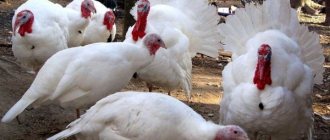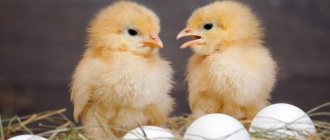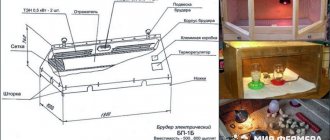Features of cellular content
Positive sides
Let's look at the benefits of keeping laying hens in cages at home.
Saving money, time and space: no need to walk chickens. It becomes possible to place a large number of heads in a small area.
Due to their sedentary lifestyle, chickens need less food. But they still grow fatter.
The chickens are safe. No need to worry about them getting lost. Or something might happen to them while walking.
Additional benefits
The cage can be upgraded by setting up automatic feed supply, humidity or temperature control.
It doesn't take a lot of farmers to care for chickens. One person can handle this. Even if there are more than 500 heads in cages.
There is no need to contact the birds directly. After all, they can be carriers of dangerous diseases.
Adults can be kept in cages separately from young animals. This also minimizes the risk of transmission of infection.
Flaws
Buying quality cells is not a cheap pleasure. You will also have to spend money on automatic feeders, drinking bowls, a temperature and humidity control system, and electricity. The solution is to make it yourself, which we will discuss below.
Inactivity of chickens negatively affects their health. Some breeds are not intended for cage breeding at all.
It is necessary to regularly feed the flock with special supplements and vitamins, which also costs a lot of money.
Laying hens lay eggs more slowly. And the period of their productive activity is reduced by almost half.
Epidemics in cells spread at high speed.
It is necessary to systematically clean the cages.
Conclusion
Keeping chickens in cages is beneficial if the family decides to create a small farm - about 10-20 chickens.
Or vice versa - if farm production is very large - more than 500 heads.
"Yes or no"?
The choice of method of keeping, like many other things in life, remains with everyone who decides to start raising chickens at home, the main thing is that it is not spontaneous and thoughtless: after all, we are talking about living beings who will also supply humans real homemade eggs. True, a lot also depends on where he lives: for example, an apartment, a house in the urban private sector or a dacha does not leave much choice.
If, given the options, you have weighed and considered everything and decided to keep chickens in cages, the first and most important thing to do is to make a cage with your own hands or buy a ready-made one. You can, without further ado, purchase a cage battery with a long-range aim - they say, the chickens will multiply, it’s a pity to slaughter them for meat, and there’s nowhere to house them... But sooner or later you’ll still have to slaughter the chicken, and the presence of a battery may simply be unjustified from various points of view . However, here too it’s up to you to decide.
Standard industrial cages are made as follows: the frame is made of a metal corner with a galvanized mesh stretched along the sides with small cells. The floor in them is made of mesh, pitched, has a slight slope, and in front there is a gutter, which allows the eggs to easily and carefully roll into it and prevents them from being beaten. These batteries are installed on stands with trays designed to collect droppings. At home, individual fragments or elements of such a battery are often used for the cell.
When making a cage with your own hands, you can use not only metal for the frame, but also a wooden beam measuring 50 by 50 mm, and even a profile for drywall. The main thing is that it is tough and stable. As in a battery, the walls of an individual cage are covered with a chain-link wire mesh, onto which a feeding trough is attached, and at a height of 10-15 cm from it there is a drinking bowl. As for the floor, it can be variable, solid or mesh, but it must be made inclined at a slight angle of 7-9 degrees. A gap of 8-10 cm is often left between the front wall and the floor. For a solid floor, it is best to use wood: the bedding will not slide on it and expose individual areas. However, it should be taken into account that such a floor requires the constant presence of dry bedding in the cage - that is, the cage must be cleaned regularly. In addition, if it is present, experts recommend increasing the height of the cage by 15 cm.
The good thing about a mesh floor is that droppings fall into the cells (which is why they put a special tray underneath), and because you don’t have to spend money on bedding. In addition, it can be equipped with a chute along which the eggs roll into an egg collector (as in industry). It must be attached so that the chickens cannot reach the laid egg (sometimes this is noticed behind them). In general, the following requirements apply to a homemade mesh floor:
- metal wire thickness 3-5 mm;
- the presence of small cells measuring 15x15 mm.
- Over time, the floor should not sag.
There are different opinions about what walls can be made of. Some experts argue that under no circumstances should they be made solid, others that all walls, except the front one, can be made of plywood, chipboard or OSB, and motivate this by the fact that this way it will be possible to avoid drafts, which chickens are afraid of. But they all have one thing in common: the front wall must be made cellular so that the hen has the opportunity to eat, drink normally and admire the world. For the front mesh, rods are usually used, placed at a distance of 5 cm from each other, or mesh wire with cells of 5 by 5 cm.
When making a cage, you should be guided by the minimum sanitary standards, which we cited at the very beginning of this article, but the dimensions can be varied at your discretion - naturally, in the direction of increasing them. Some poultry farmers, without bothering themselves with long, precise calculations, simply make a square cage for one or two chickens at the rate of 0.45-0.5 per 0.45-0.5 meters (for one chicken) or meter per meter for two . The rule in this case is simple: the larger the cage, the more spacious and comfortable the chickens will feel in it. The main thing is to comply with the so-called. “stocking density” and do not house more than 7 chickens in a cage. Although you can find information that up to a dozen laying hens are allowed to live in one cage, it is better to be skeptical and remember that the lack of free space and the high density of livestock per 1 sq. meter is often the cause of cannibalism in chickens. When seating, one nuance should be taken into account: chickens of the same age and breed should be placed in one cage. This will avoid quarrels between them.
You should definitely make a pull-out tray for litter for the mesh floor, leaving a gap of at least 12 cm between them. It should be cleaned as needed. The material from which it is made is the same as that used for the cage - galvanized mesh. The roof of the cage can be made from plywood, slate or OSB board.
There is another cage option that may appeal to those who have a small area. This is a cage-house with a frame attached to it, covered with mesh. The mesh forms a small pen in which the chickens will feel great. In appearance, such a design will resemble an aviary, only smaller in size. This type of cage will solve many problems associated with caged chickens, and above all, the problems of inactivity, variety in feeding and the need for controlled constant lighting.
On small farms, you can combine elements of two types of housing: walking and caged. In this case, when using cellular contents, some additional conditions must be observed:
- per chicken there should be approximately 8-10 cm of feeders and 2 cm of drinkers.
- If the cage is equipped with a nipple drinking system, then there are usually 5 chickens per 1 nipple.
- The constant temperature in the room should be at +16-18. In summer, ventilation should be increased and the room temperature should not exceed 28 degrees Celsius, otherwise the hen will reduce egg production. A further increase will lead to the death of the bird from heat stroke.
For home conditions, it is not necessary to comply with such requirements, but it would also be a good idea to completely ignore them.
Separate mention should be made of ventilation. A chicken is characterized by an intense metabolism, and when breathing in 1 hour, it consumes about 1 liter of oxygen per 1 kg. mass, releasing a lot of hydrocarbons. Its presence with poor ventilation has a negative effect on chickens, causing depression, lethargy, weakness, loss of appetite... Accumulating, these signs can lead to a reduction in livestock. Therefore, the power of the fans in the poultry house should be such that the air in it changes three times in one hour.
It is also necessary to equip the poultry house with adjustable artificial lighting and heating and monitor the humidity level: it should reach 60-70%.
Broilers can also be raised in such cages, both on farms and at home. Perhaps their breeding will be a more correct solution: it is known that broilers only need light space, which means their planting density per 1 sq. meter can be higher than ordinary chickens. But it should be taken into account that the cage for them should be more illuminated and durable. The technology for making it yourself is no different from making a cage for laying hens.
What a cage should be like: norms and rules
Options
The walls are made of steel. They do not have to be continuous, so they are often made in the form of a mesh of rods. The openings are 50 millimeters wide. And the height is 100 millimeters.
This cell structure will ensure sufficient air supply. Chickens will not be bothered by increased temperature and humidity inside.
It is important that the diameter of the sex rods is at least 2.5 millimeters. Otherwise, the bottom of the cage will bend under the weight of the chickens.
The floor should be inclined so that the eggs roll into the compartment intended for them.
Dimensions
Now let's look at the cell sizes when keeping laying hens in cages at home.
According to the standard, the cell parameters are as follows: depth - from 0.5 to 0.7 meters. Width – about 1.5 meters. Height – 0.7 – 0.8 meters.
But the cage area directly depends on the number of chickens and their age. Maximum values: per 1 square meter there can be no more than 10 adults and 20 chickens.
For example, if there are not many laying hens and you plan to keep one in a cage, then there should be at least 0.5 square meters per head. More free placement will entail greater losses.
If you do not pay attention to the established standards for keeping chickens in cages, this will lead to negative consequences. To serious illnesses and even death of chickens. They can suffer serious physical injuries: broken legs and wings.
Equipment
Each cage should have a removable feeder and drinking bowl.
The room where the cages are located must be equipped with:
- artificial lighting (for chickens to lay eggs better, there should be yellow, orange or red light);
- ventilation system that promotes air circulation;
- heating equipment;
- automatic water and feed supply systems (this is not necessary).
How to choose a cage for chickens
Cages for poultry can be made with your own hands or purchased ready-made. They are a rectangular box with a floor and a front wall made of mesh, a floor inclined at an angle of 7–10 degrees and grooves for rolling eggs. At the bottom of the cage there is a litter tray. It is desirable that the roof be removable - this makes it convenient to remove the birds if necessary, and to clean and disinfect the box.
When choosing, you need to pay attention to the following nuances:
- Durability - the bars and walls should be made of materials that the chicken cannot break through or damage with its beak, the floor should support the weight of the bird.
- Safety - all fastenings must be securely hidden and free of burrs and sharp areas that could injure the bird.
- Environmental friendliness - since chickens and their eggs are consumed by humans, their housing should not contain substances that can negatively affect both the body of the birds themselves and the human body (usually the cages are made of wood and metal profiles).
- Durability - the materials from which the cage is made should last a long time.
- Convenient to use, clean and collect eggs.
- Convenient when feeding and pouring water.
- The size of the cells should be such that the hen cannot get stuck in them.
- Availability of artificial lighting.
- Removable drinkers and feeders - cages can be sold complete with equipment for watering and feeding; it should be easily removed for washing and treatment with disinfectants.
If the farm is large, then you need to opt for cellular batteries made of mesh and metal profiles. If it is possible to place birds outdoors in the summer, then it is worth considering the option of portable structures.
Installation
Where can I put it?
Cages should not be placed outdoors or in any room. It is necessary to take care of arranging a functional chicken coop.
An equipped additional building at the dacha can serve as such a room. You can also raise chickens in a garage that has been converted to the right conditions.
Cages should not be placed in living areas. Otherwise there are no restrictions. The main thing is to follow certain rules.
Nuances
The area of the building must correspond to the number of cells. A chicken coop that is too large will be uneconomical. After all, a lot of electricity and heat will be wasted.
It is important that there is enough space between the cells for a person to pass through.
It is necessary to take care of the ventilation of the room. Stale air provokes the development of diseases. The chicken coop is saturated with caustic fumes, which can lead to the death of chickens.
In the chicken coop, in addition to the cages with the chickens, there should be two separate tanks with water and feed. If necessary, an incubator.
It is recommended to think over the structure of the chicken coop. For example, you should not make doors too narrow. Otherwise, it will be difficult to carry massive boxes and cages.
It is recommended to make an extension in the form of a corridor in front of the main room. Two doors will help keep the heat in during the winter season.
How to organize accommodation for laying hens correctly?
The cages where the birds will be kept are made of five-tier columns of three- or five-tier batteries made of wooden materials or metal. The floor with this content is made of metal rods. A small gutter is formed on it from the outside of the cage, and the floor itself is placed at a slight slope. Eggs collected from the cells will fall into the groove.
In the photo below you can see what chicken cages look like, which can be arranged in several tiers:
To collect droppings, trays are installed under the floor , which can be easily pulled out for cleaning. In non-mechanized cages, a drinking bowl and feeder are hung on the front part in front of the door. As a rule, one drinking bowl is installed on two adjacent cages. Most often, it is completely mechanized, like feeders for laying hens.
Proper organization of chicken keeping includes many important points, and this applies not only to cages.
Read about the organization of feeding and watering chickens, as well as how to make feeders and drinking bowls with your own hands in detailed materials on our website.
In the winter season, heating of the poultry house with cages is mandatory. In winter, the temperature should be maintained at 16 degrees, and in summer - at 18 degrees.
To cope with this task, you will need information about building a chicken coop and the accompanying actions.
We bring to your attention useful articles on how to build a chicken coop yourself, as well as what types of perches there are and how to make them with your own hands, and how to arrange a nest for a laying hen.
Lighting
Due to the lack of free range, laying hens are forced to receive light from artificial sources.
The fact is that lighting has a beneficial effect not only on the health of laying hens, but also on egg production.
It is especially important to establish proper lighting in the chicken coop during the cold season, when by nature the birds stop laying eggs.
In the room where cages with birds are located, there should always be uniform lighting . In no case should you allow the formation of too dark and too light corners.
To create uniform lighting, professional poultry breeders use rheostats, which can both adjust the brightness and gradually turn on the light.
Turning on the lights gradually is necessary to reduce the birds' stress. In addition, the illusion of a change in time of day is created, so birds perceive such lighting as quite natural.
Often, to improve the egg production of birds on large poultry farms, different color spectrums are used . Poultry farm owners constantly alternate the spectrum of red, orange and yellow colors, which have a beneficial effect on the egg production of poultry; the chickens become calmer, which immediately affects their health.
Feeding
In cage-based conditions, laying hens must receive a well-balanced feed, since they do not go out to range. Most often, laying hens in factory conditions are fed with compound feed. They begin to give it from the beginning of puberty until the end of egg laying.
Loose feed is ideal for feeding laying hens living in cages. Birds will collect food for a long time, spending most of the day doing this activity. For birds with limited mobility, this method of feeding will come in handy, since they will spend some energy during intensive pecking of food.
The composition of crumbly food must include wheat grains, calcium carbonate, sunflower cake, any vegetable fats, salt and vitamins . Under no circumstances should you use feed with the addition of drugs and dyes, as the laying hen’s body may not be able to digest such feed.
It is believed that the best feed for chickens should contain 15% protein, 5% fat, 6% fiber and a small amount of useful minerals and vitamins.
The most detailed information about feeding is collected in the corresponding section of the site.
In the articles you will find everything about preparing a diet depending on the season, find out what types of feed exist and how feeding young animals, roosters and laying hens differs.
Laying hens kept in battery cages are fed using automatic feeders. The food falls into special chutes near the cages, where the chickens quickly peck it.
You can see what the feeder looks like in the diagram and photo below:
At the same time, birds should have free access to water. On average, each laying hen should drink at least 500 ml of water per day, so you need to worry about arranging drinking bowls in advance.
The most common type of drinker used on a poultry farm is a trough drinker. It consists of a gutter through which water flows, fasteners, a valve and a drain pipe. These automatic drinkers are very convenient to use, as they require short pipe lengths for installation. But they need to be washed periodically, since the drain pipes often become clogged and fail.
Nipple-type drinkers are also often used. You can see examples in the photo below:
How to build a cage yourself
The budget does not always allow you to buy ready-made cages for keeping laying hens.
It is more profitable to make a house for chickens yourself. It's also more convenient. After all, you can build a cage of the required size. And from any material. In addition, the master will be confident in the quality of the structure made.
Useful tips and DIY options are presented in the article “How to make a cage for laying hens with your own hands.”
Not all birds can live in limited conditions. 4 breeds of caged chickens are excellent for this role. Let's consider their features.
Advantages and disadvantages
The proliferation of cellular content is due to a large number of positive aspects. The list of main advantages includes the following:
- Possibility of raising chickens in a small area or in the same room with cattle.
- Ease of daily care, feeding, waste removal and egg collection.
- Convenient monitoring of the condition of birds, inspection and rejection of unsuitable individuals due to the fact that the chickens are constantly in the field of view.
- Protection from interaction with wild birds that carry dangerous infectious diseases.
- Feed savings achieved through external fixation of the feeder, which eliminates food scattering.
- Separating chicks and adult chickens into different places.
- Convenience of collecting eggs from special trays, which minimizes the likelihood of pecking and crushing.
In addition to a number of advantages, several negative characteristics can be identified. In particular:
- The limited space will restrict the movement of the chickens. Inactivity and rare walks in the open air negatively affect productivity.
- To provide all the amenities for the birds, you will need to install automatic feeders and drinkers, as well as maintain a certain temperature. This will increase labor and material costs.
- Certain breeds of chicken are not genetically suited to being kept in confined spaces.
- A short stay in the open sun reduces resistance to disease, which is why the condition of some laying hens is depressed.
See also
17 best models of household incubators for householdsRead
Breeds suitable for cage keeping
Loman brown
These are highly productive layers. They produce about 350 large eggs annually.
Loman browns are capable of laying eggs starting at four months of age.
Unfortunately, the wearing period for such a chicken is only one and a half years. After which it is used for meat. The advantage of this chicken variety is the high survival rate of chicks - up to 97%.
Hisex brown
The main feature of eggs from such chickens is their low cholesterol content.
Highsex Brown chickens lay intensively for 80 weeks, starting at four months of age.
The annual number of eggs from one chicken can reach 350 pieces. The eggs are large. One weighs about 70 grams.
Leghorn
Representatives of this breed of chickens can live in open conditions and cages. They quickly adapt to their surrounding conditions.
One hen can lay about 310 eggs annually, starting at the age of five months.
The egg size is slightly smaller than the varieties described above. And it is about 60 grams. Intensive wear lasts for a year. Then the process slows down.
Kuchin anniversary
Adapts well to limited conditions. Despite its unpretentiousness, it does not lay as many eggs as its brothers. Annually - no more than 180 eggs. If you create ideal conditions, then during the active period - up to 250 eggs.
It is not recommended to keep large laying hens in cages: Brahms, Hungarian giants, dominant crosses, Australorps. It will be difficult for them to survive in such conditions.
Suitable breeds
Representatives of the following breeds and crosses are best suited for cage keeping:
A breed of chickens for egg production, proven by time and many generations of poultry farmers.
Leghorn
An egg cross that even a novice farmer can maintain
Hisex brown
Characteristics, maintenance, breeding, diseases
Kuchinskaya
Cross from Germany, bringing great financial profit to its owners
Loman brown
Necessary conditions of detention
Air temperature
In order for chickens to be healthy and lay eggs well, it is necessary to monitor the conditions in which they are located. And control some aspects.
The temperature should not fall below 15 degrees. And rise above 35 degrees. If the temperature is not within the specified range, the chickens will stop laying eggs. The optimal temperature is 20-25 degrees.
Find out more in the article “What should be the temperature in the chicken coop in winter and summer.”
Humidity
The optimal humidity that should be maintained in the chicken coop is 65-70%. If it is higher or lower, it will negatively affect egg production and the general condition of the chickens.
A special device called a hygrometer will help you monitor the humidity level.
Weather protection
You need to approach the construction or selection of a chicken coop responsibly. It is important that nothing leaks during rain or snow melt. Dampness and mold formation can cause health problems in chickens.
Heating must also be adjusted to the weather conditions.
Diet
When kept in cages, laying hens need a special diet. It is important that the diet is complete and balanced. Otherwise, the chickens will not be able to fully perform egg work.
An industrial feed containing vitamins, minerals, wheat and barley grains, and vegetable fats has been developed especially for them.
But this food contains little protein. To replenish it, laying hens are given corn, beans, and meal (bone or fish).
To maintain the strength of the shell, commercial calcium supplements are added to the diet.
Experienced farmers independently calculate what percentage of the diet should be proteins, fats and carbohydrates. A complete feed should consist of 15% protein, 5% fat and 6% fiber and mineral supplements.
An adult should eat no more than 4 times a day. Excess will lead to obesity. For the same reason, the diet should not be too high in calories.
Getting enough vitamin D
Already 2 weeks after laying hens are placed in a cage, they begin to develop vitamin deficiency. Especially due to a lack of vitamin D. The main indicator of vitamin deficiency is brittle shells and a decrease in the number of eggs.
To regulate the amount of vitamin D, you need to introduce synthetic vitamin D3 into your food. Vitamin therapy is carried out once every 2 months.
Excess vitamin D also causes health problems in chickens. Therefore, medications are introduced into the diet according to the instructions.
Control over the physical condition of birds
It is important to monitor the health of chickens. This will help in time to prevent illnesses associated with inactivity and poor nutrition.
Laying hens that arrive in captivity do not have the opportunity to move and walk like ordinary chickens. Therefore, they often develop diseases associated with a sedentary lifestyle:
- obesity;
- leg transformation;
- prolapse of the oviduct;
- rickets;
- cannibalism (pecking);
- avitaminosis.
Constantly keeping laying hens in cages has a detrimental effect on their condition. If there is an opportunity to let them into the meadow for at least a few hours, you need to take advantage of it. Even irregular walking will help get rid of obesity and deformities of the birds’ limbs.
Lighting control
It is important to maintain artificial lighting in the coop. Otherwise the chickens will stop laying eggs.
Lighting is one of the main points of cage keeping of laying hens. All information about setting the right light is given in the article “Winter and summer lighting in the chicken coop.”
Keeping it clean
It is recommended to remove any remaining food from the cage every day, monitor the cleanliness of the water, review the condition of all chickens, and remove litter from the trays.
Cleanliness in cages is the key to healthy chickens and quality eggs.
We advise you to familiarize yourself in detail with the sanitary and hygienic rules in the article “Methods of disinfecting a chicken coop at home.” The information is also relevant for cage keeping of birds.
Cages can cause mental and physiological problems in laying hens.
How to keep chickens in cages at home
When laying hens are caged, feeding and care will be carried out in a special way.
We recommend that you familiarize yourself with the features of keeping chickens in a polycarbonate greenhouse.
Feeding
Since during cage breeding birds cannot obtain food for themselves and replenish the body with the necessary vitamins and microelements, their feeding differs significantly from the diet of free-range chickens. Such chickens are fed with premixes and compound feeds, possibly with the addition of grass and vegetables.
If a regular diet is used, eggshells or a calcium supplement must be added to it. The daily menu should contain 72% carbohydrates, 15% proteins, 2% vitamins, 6% fats, 3% fiber, 2% minerals. This can be achieved by creating a diet of grains, sunflower cake, vegetable and animal fats, calcium carbonate, vitamins, and salt. Be sure to introduce meat and bone meal, fish meal, and blood meal. It is useful to give fermented milk products twice a week. We must not forget that chickens need gravel to improve digestion.
Adult birds are fed three times a day. The daily portion is 120–130 g.
Did you know? In Indonesia, chickens were bred that were completely black, including the comb, limbs and even the bones.
Care and cleaning
It is necessary to adhere to the following schedule for caring for birds and cleaning cages:
- Once a day - cleaning up droppings and garbage, washing the tray for collecting excrement.
- Once every 3 days - wipe the cage bars, feeding equipment and water supply with a disinfectant.
- Once every 14 days - treatment of the insides of cages and trays with disinfectant solutions and removal of birds.
Possible problems
Cellular fatigue
Caging hens in cages tires their bones and muscles.
The bird loses the ability to stand on its feet due to brittle bones. Because of this, she constantly lies down and stops eating. Egg shells become thinner.
When such a disease appears in chickens, you need to pay attention to their nutrition. Add calcium and phosphate to the menu.
Panic
When a hen is about to lay eggs, she needs privacy. It is impossible to achieve such conditions in a cage. Because of this, the hen begins to panic. She begins to rush around the cage randomly, breaking off feathers and injuring her limbs. As a rule, this goes away after 2-3 layings.
The solution is to isolate the restless bird. And creating comfort for her: a cozy nest, dim light, closed walls, warmth. It is important to diversify her menu with useful substances. For example, fruits, vegetables, herbs, worms, chalk.
Cannibalism
Adult laying hens can show aggression towards cage mates. Peck, pounce.
It is recommended to separate such chickens from the general flock. There are even more tips in the article “Chickens peck each other until they bleed: why and what to do.” If all else fails, the aggressor is slaughtered for meat.
Wing fracture
The fracture is difficult to detect if chickens are kept in cages.
If your chicken can't straighten its wing, or if it's drooping, it may be injured or broken. It’s the same with the paws if the bird falls and cannot get up.
It is better to show the laying hen to a veterinarian. If this is not possible, you need to fix the affected wing or paw with a splint and bandage in its natural position.
Rickets
This disease is common among laying hens and young chickens. Signs of the disease: loose stools, loss of coordination and appetite, softening of the key and claws. It is not easy to recognize in the early stages. Patients must be isolated and treated:
- tricalcium phosphate: 1.5 milliliters per 100 grams of feed;
- fish oil: 0.5 milliliters per 100 grams of food;
- vitamin D2 concentrate: 2-3 drops per kilogram of feed.
No matter how long chickens live in cages, all this time they need care. It is recommended to systematically inspect, monitor the nutrition and living conditions of laying hens.
If you liked the article or have experience keeping chickens in cage conditions, please leave comments and share your knowledge. Perhaps your opinion will be useful to our readers.
Please spread the information on social networks by reposting. Special thanks to everyone for rating this article 5 stars.
Quality cells are the key to success
To achieve high egg production rates in birds, there are a number of requirements for cage design. The walls and ceilings are made of steel lattice to provide the birds with access to fresh air and ventilation. The pallet mesh is made of rods with a diameter of at least 2.5 mm. It is placed at an angle of approximately 7°. Thanks to this, the structure can withstand the weight of livestock in one cage.
The front side is made of rods. The width between them is about 50 mm, and the height is 100 mm. It is convenient for birds to eat through these openings. Drinkers and feeders are securely attached to a metal structure. However, they are made removable for regular cleaning and, if necessary, repair.
In addition, the density of laying hens in cages should be taken into account so that they feel comfortable “in captivity”. It depends on the dimensions of the structure, breed and age of the chickens. For example, for an adult, 0.2 m² is enough. One standard cage contains from 2 to 11 individuals. If the birds previously lived in a spacious chicken coop, then the required space doubles.
Birds of different age categories and breeds cannot be “placed” in one section. Otherwise, conflicts will arise between them, which will affect egg production.
Cell requirements
There are certain requirements for the size, climatic parameters and lighting of bird houses.
Dimensions
As we have already noted, cages can be purchased, with standard sizes, or made by hand. The main size requirement is the ability to maintain the recommended planting density.
Standard cages that can accommodate 5 individuals usually have a length of 1–1.4 m, a width of 0.5–0.7 m, and a height of 0.7 m. For 10 individuals, a dwelling with minimum dimensions will be required: length — 2 m , width - 1 m, height - 0.7 m. These parameters will vary depending on the manufacturer. The minimum recommended housing area is 0.5 square meters. m.
To accommodate the maximum number of laying hens in one room, cages can be placed in several tiers. A system for removing litter is installed underneath them.
Stocking density and placement of chickens
No more than 10 individuals are placed in one standard cage. The exact quantity will depend on the breed and size of the individuals. The recommended area for one individual is 0.5–0.6 square meters. m.
It is worth paying attention to the fact that chickens of the same breed and age must be placed in one cage. Otherwise, difficulties will arise with feeding and selecting food.
It is important not to overcrowd the cages, otherwise the birds will often get sick, they will be very uncomfortable, and it will be difficult for the owner to provide care.
Temperature and lighting standards
In the room where the cages are located, it should be controlled that the temperature does not go beyond +16–18 °C. Raising the thermometer above +30 °C has a detrimental effect on productivity, above +36 °C threatens heat stroke.
Necessary equipment
To maintain the egg production of chickens at the required level in cage conditions, the chicken coop must be equipped with:
- Artificial lighting;
- Ventilation system;
- Heating;
- Automatic drinkers.
To automatically supply water to each drinking bowl, the cages use a vacuum type of water supply. Why install one common tank (or system of tanks) above the level of the drinking bowls of the upper tiers. Flexible tubes extend from the tank into each drinking bowl. It should be remembered that the tank must be hermetically sealed, then the water in the drinkers will be filled strictly to the edge of the tube suitable for it.
The crowded presence of chickens in cages requires the installation of electric fans to ensure good air circulation in the chicken coop and prevent the accumulation of moisture.
For lighting you can use:
- Incandescent heat lamps;
- Energy-saving lamps;
- LED bulbs.
It is better to use LED lamps, since energy-saving bulbs in the form of a spiral, when broken, will pollute the chicken coop with mercury vapor, which will lead to illness in laying hens, and incandescent lamps consume 9 times more electricity than LED frosted lamps.
Every two sq. meters of chicken coop with cages should be illuminated with a 100-watt lamp (for incandescent heat lamps), or a 12-watt LED lamp. When distributing lights, it is important to avoid establishing dark areas in the coop. Daylight hours for laying hens should last 14-16 hours.
To automatically maintain this mode, timers are used, and if you have windows, you can save on lighting during the day by installing a light-sensitive sensor that will turn off the lamps during the day.
Features of feeding
To properly organize the cellular contents of laying hens, study some of the features of their life. The main feature of this type of poultry is the need for free range.
However, professional poultry farmers are more and more often inclined to believe that properly organized cage care will not reduce the number of eggs produced by a chicken. It is enough to properly place chickens in cages at home.
However, we note that in the conditions of cage keeping, chickens of various breeds will not be able to fully reproduce: if for laying hens walking is not so important, then for roosters this is an important factor. For this reason, if you fertilize eggs and hatch chicks, the birds will still need to be placed in a more open space.
A rooster should not be kept in a cage
To ensure good egg production and minimize the risk of disease, it is important to comply with certain conditions:
- Good lighting. The ideal option is a seventeen-hour daylight hours; warm spectrum light is preferable. The cages are placed so that all birds have enough light; shadow areas should be avoided.
- Fresh air. The chicken coop is ventilated 2-3 times a day, but direct exposure of the birds to cold air is unacceptable.
- Stable temperature throughout the day. The optimal mode is 20-25 degrees.
- Moderate air humidity. The hygrometer should show 50-70%; a sharp increase in humidity is unacceptable.
Cages require frequent cleaning and disinfection. At least once every 3 weeks, the birds are removed, the walls, floors and doors of the cages are treated with safe disinfectant solutions and thoroughly dried. This treatment will prevent infectious diseases and stop the spread of parasites (ticks, fleas, lice eaters).
Forced molting can extend the period of bird productivity. Organizing the process is not difficult. For half a day the bird is left in the dark, while food portions are reduced. Then the lighting turns on again, and vitamin components are included in the menu. Short-term switches renew the chickens’ body, they begin to actively change feathers, eat with greater appetite, and the number of eggs increases.
Moderate shedding of chickens is considered normal
The dimensions of a standard room for chickens are depth 0.5-0.7 m, width – up to 1.4 m, height – 0.7 m. This cage can accommodate 5-8 laying hens.
The best material is thick steel mesh with not too small cells. This material provides good air exchange, the bird does not suffer from stuffiness and high humidity. The mesh is stretched over metal or wooden bars. Feeders and drinkers should not be too deep and easy to remove.
Standard cages are sold in specialized stores, but many poultry farmers prefer to save money by assembling them themselves
Rooms for egg crosses can be relatively small; one bird needs at least 0.06 square meters. m. Meat breeds need more space, they need at least 0.08 sq. m on the head. One cage can contain from 2 to 12 chickens. It is important to remember that overcrowded housing favors the spread of infections.
Many owners, limited in space, place cages in tiers. However, this method worsens illumination, and birds reduce egg production. It is better to arrange the cages in a single layer or place them on racks with large gaps. It all depends on the size of the chicken coop, its height, and the number of birds.
It is better not to place chicken cages in tiers.
For ease of maintenance, all cages are connected by an egg receptacle. Drinkers and feeders are attached to the outside. Uniform lighting is ensured by rheostats; they turn on the light gradually so as not to frighten the bird. The device is capable of independently adjusting the brightness of the lighting and changing its spectrum. Lamps with yellow, red, orange filters have a positive effect on egg production.
Infrared radiation has a beneficial effect on chickens
To prevent parasites from breeding in the cells, you need to install deep ash baths. Wooden boxes are filled with wood ash mixed with fine river sand and dust. Chickens will be able to regularly clean their feathers, getting rid of lice and mites.
Ash treatments protect chickens from insects and bacteria
If there are a lot of chickens, it is worth automating the process of supplying water and feed. The most convenient are vacuum drinkers connected into a single system. A common tank made of plastic or metal is installed on a raised platform, and flexible tubes leading to drinking bowls are taken from it. To keep them filled to the brim but not overflow, the tank is equipped with a sealed lid.
If there are a large number of chickens, the supply of feed and water should be automated. You can make the system yourself and it will not cost much.
A fan system will help provide fresh air. They are placed in different corners of the chicken coop and turned on at least 3 times a day. LED or energy-saving lamps are used for lighting. Conventional incandescent lamps are very short-lived and do not withstand a seventeen-hour light cycle. In addition, such devices consume much more electricity and can cause network overload.
Lamps must be well insulated and securely secured. It is logical to place a heating system nearby
The lighting standard is a 12-diode LED lamp for every 2 square meters of the room. The lamps need to be distributed evenly; with tiered lighting, they should be installed above each row of cells.
The well-being of chickens, their egg production and fattening speed depend on the correct choice of diet. It is important to maintain the correct balance of nutrients. Some novice poultry farmers focus on carbohydrates, which the bird quickly gains weight by consuming. However, this approach contributes to the accumulation of fat, the meat becomes less tasty, and the productivity of laying hens decreases. The menu should contain animal and vegetable proteins (at least 10, and preferably 15%), fats (up to 6%), minerals and vitamins.
The percentage of plant and animal proteins in the chicken diet
The best choice is industrial feed with a balanced composition, including grains of wheat, barley, cake, vegetable fats and vitamin complexes. Loose feeds are easier to feed, they are readily eaten by chickens and stimulate digestion.
Grain mixtures are nutritious, but not too rich in protein. Adding legumes, corn, bone meal or fish meal will help increase its amount. Be sure to combine plant and animal protein. Calcium supplements will help strengthen the shell. Some owners add crushed eggshells to the food; this is a cheap alternative to industrial calcium complexes.
Crushed shells are an excellent alternative to special calcium supplements
Birds should always have access to clean water. The drinking bowls are filled daily and need to be washed and disinfected from time to time. A chicken needs about 0.5 liters of water per day. A bird deprived of a free range cannot peck pebbles, sand, insects, or fresh grass, so the farm owner must take care of fiber and mineral supplements.
Freshly cut grass improves chicken digestion
Adult chickens eat 2 times a day, the average portion is 120-160 grams of grain mixture or other feed. After the meal, the feeders must be cleaned of residues to avoid food spoilage and poisoning of the laying hens.
How to care for a bird house
An isolated room containing a large number of birds requires constant cleaning and disinfection. Every day or at least once every 2 days you need to wipe the house with a damp cloth. After each meal, all containers for water and food should be washed thoroughly. Several times a day, litter should be removed from the pallets and disinfected with alcohol or a solution of potassium permanganate.
Keeping laying hens in cages requires particularly careful care for the health of the birds, because the overall resistance of the body is reduced. If it is not entirely clear how to care for birds using a cage breeding system, you can watch videos made by experienced farmers who have been using this method for a long time.
Equipment for arranging cages
The feeder and drinker are placed on the front mesh wall. The feeder runs along the entire length and at a height of 10–15 cm from the floor. It is important to ensure that there are 8–10 cm of feeders per individual. Typically, feed equipment is made of food-grade plastic or galvanized iron.
It is advisable to use a nipple drinker - this is the most convenient option for chickens. On average, one individual needs about 0.5 liters of water per day to quench thirst and normal functioning of the body. For 5 chickens you will need 1 nipple. It is better to pour settled water into drinking bowls.
Nipple drinker At a distance of 10–15 cm under the cage, place a retractable zinc tray into which bird excrement, feathers, fluff and other debris will be collected. A trough for collecting eggs is installed at the same distance. At its end there is a removable tray - eggs are rolled into it.
Possible problems and their solutions
When living in cages, birds most often experience the following health problems: osteoporosis (disease of the musculoskeletal system), deficiency of vitamins (hypovitaminosis, rickets) and minerals. Let's consider possible problems and ways to solve them:
- Osteoporosis or cellular paralysis develops due to a lack of calcium and vitamin D. It is accompanied by impaired bone growth, exhaustion, and dehydration. Prevention of this disease involves strict control of the body’s replenishment of calcium and vitamin D with food, taking into account the age and productivity of the bird.
- Another disease that often develops in caged chickens due to a lack of vitamin D is rickets. It manifests itself as softening of the beak, claws, chest, weakness, exhaustion, and poor appetite. Prevention will consist of introducing fish oil, fermented milk products, carrots, bone meal, spinach, and shellfish into the food.
- Lack of vitamin A is manifested by growth retardation, bone deformation, and decreased productivity. To prevent it, chickens should have greens, carrots, nettles, and pumpkin in their diet.
- With a deficiency of B vitamins, problems with the nervous system appear. It is necessary to ensure that the caged bird feed contains a sufficient amount of proteins, bran, and sprouted grains.
- If the cages are installed incorrectly, injury to birds and loss of eggs may occur. This problem can be solved by installing good cages with proper installation of all equipment.
- Every day, the owner of caged birds should inspect the livestock for health. If a sick individual is discovered, it must be immediately quarantined to prevent a mass outbreak of the disease.
So, cage housing of chickens is widely used today. It has a number of advantages and disadvantages. Suitable for large and medium-sized farms. Requires significant initial capital investment. Cages for keeping can be made with your own hands or purchased ready-made.
- Author: Maria Sukhorukikh
Rate this article:
- 5
- 4
- 3
- 2
- 1
(0 votes, average: 0 out of 5)
Share with your friends!
How to choose a house for pestles
Chambers should be tailored to the needs of the laying hen breed. They are mainly characterized by compact size and low activity. If you decide to buy a ready-made structure, it is important to take into account some nuances:
- so that the bird does not get hurt or fall out, the mesh cells should not be large;
- the most suitable material is metal, it is easy to clean and durable;
- the floor slope should be 7-9°;
- the distance from the pallet to the floor of the cage should be at least 15 cm;
- planting density should not exceed established standards.
It is important to choose your own design for each age category. For chickens you will need a chamber with an area of 10 square meters. cm, for grown chicks - 30 cm, and for mature individuals - 60 cm. To make cameras at home yourself, it is better to prefer galvanized metal or environmental plastic. Also an important criterion is the total weight of the livestock that will live in the cage and the materials used for construction.
Cage and house cleaning
Proper maintenance of laying hens depends on how well the cleanliness of their habitat is maintained.
To do this, you need to monitor sanitary and hygienic standards for keeping poultry. Cleaning of the poultry house should be regular, especially when it comes to cage housing of laying hens. To maintain the cleanliness of the cage, you need to wipe its bars daily . Feeders are thoroughly washed after feeding grain. If chickens are fed green feed or wet mash, then the feeders are cleaned immediately after finishing the chicken meal.
As for the litter, it falls onto special trays placed under the cages. They are cleaned with special scrapers as they are filled. After this, the droppings are sent to a workshop for processing, where it becomes a good fertilizer for plants.
You can read in detail about disinfection and hygiene, as well as how and what to use for bedding in chicken coops in separate articles.
How to make houses for pestles
Making bird houses with your own hands is quite difficult, but this way you can initially plan the location and structure of the room itself, as well as make houses tailored specifically to your breed of bird and its characteristics. In essence, it is a frame made of dense material: metal or wood. It is best to use a mesh with small cells for the walls. Alternatively, you can make all the walls from OSB and only the front part from mesh.
For the floor, metal rods are used, the distance between which is about 5 cm, no more. Special trays for feces will be installed under the cages. It is also important to take into account that the floor must be fixed at a slight slope so that the egg rolls into a groove specially designated for this, and the chicken does not have access to it. To form this groove, a small space is left at the front of the cell.
The feeder and water container are attached externally. As an option for drinking, nipple systems are used. Typically, 2 adjacent cells have one drinker and one feeder. You can watch the construction diagram of the houses in the video, where you can actually find a detailed drawing and description of the sequence of work.











